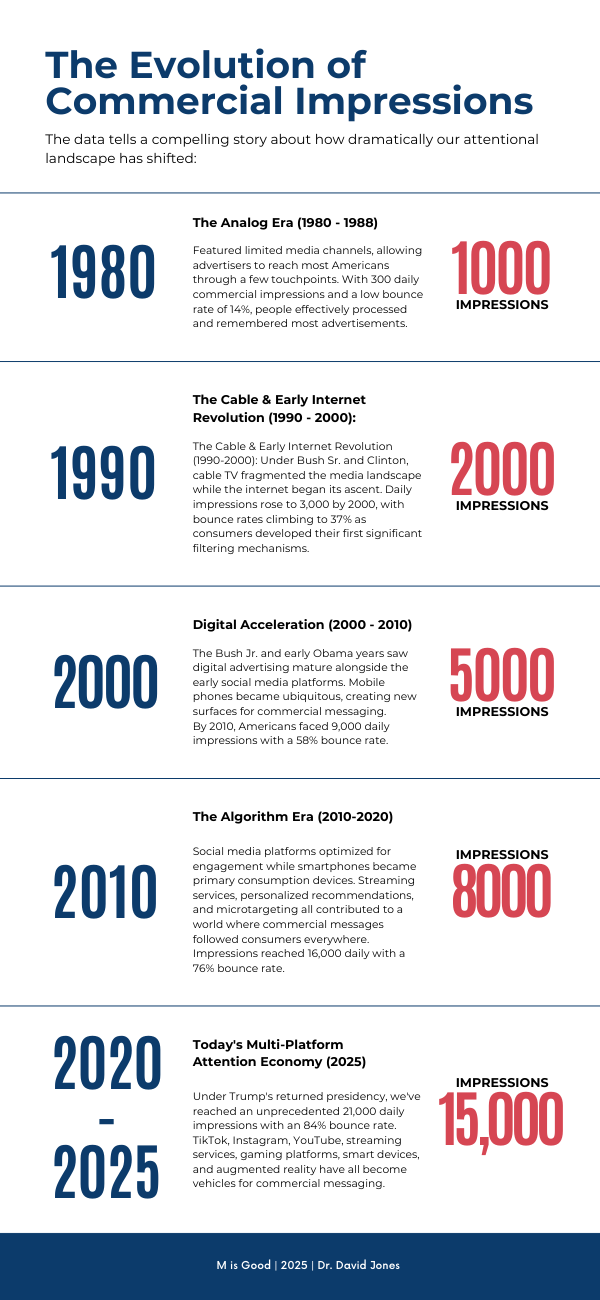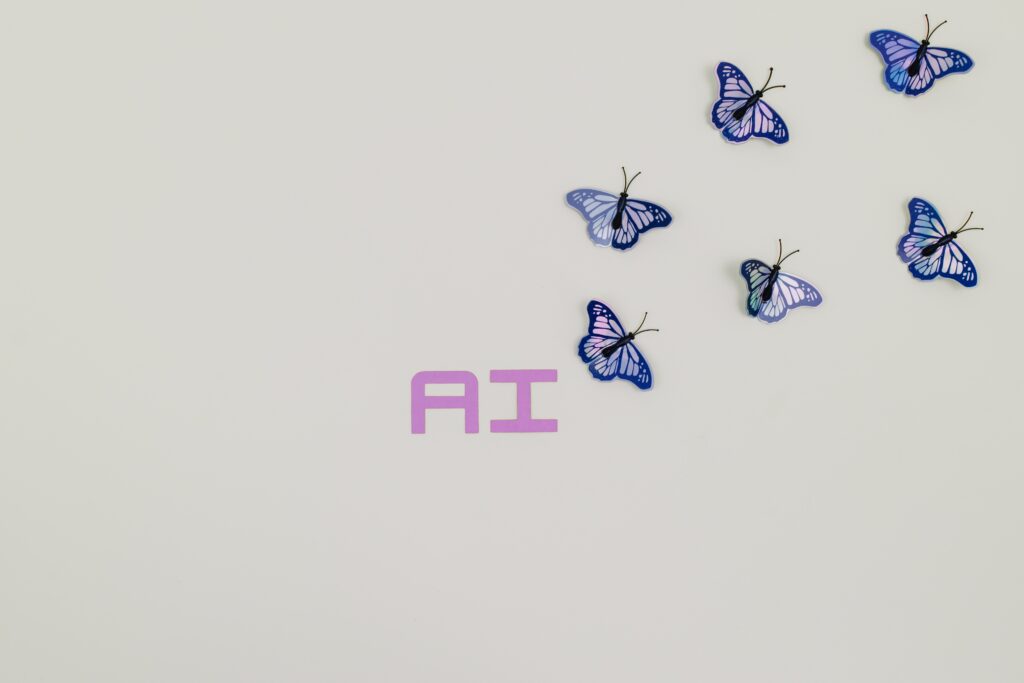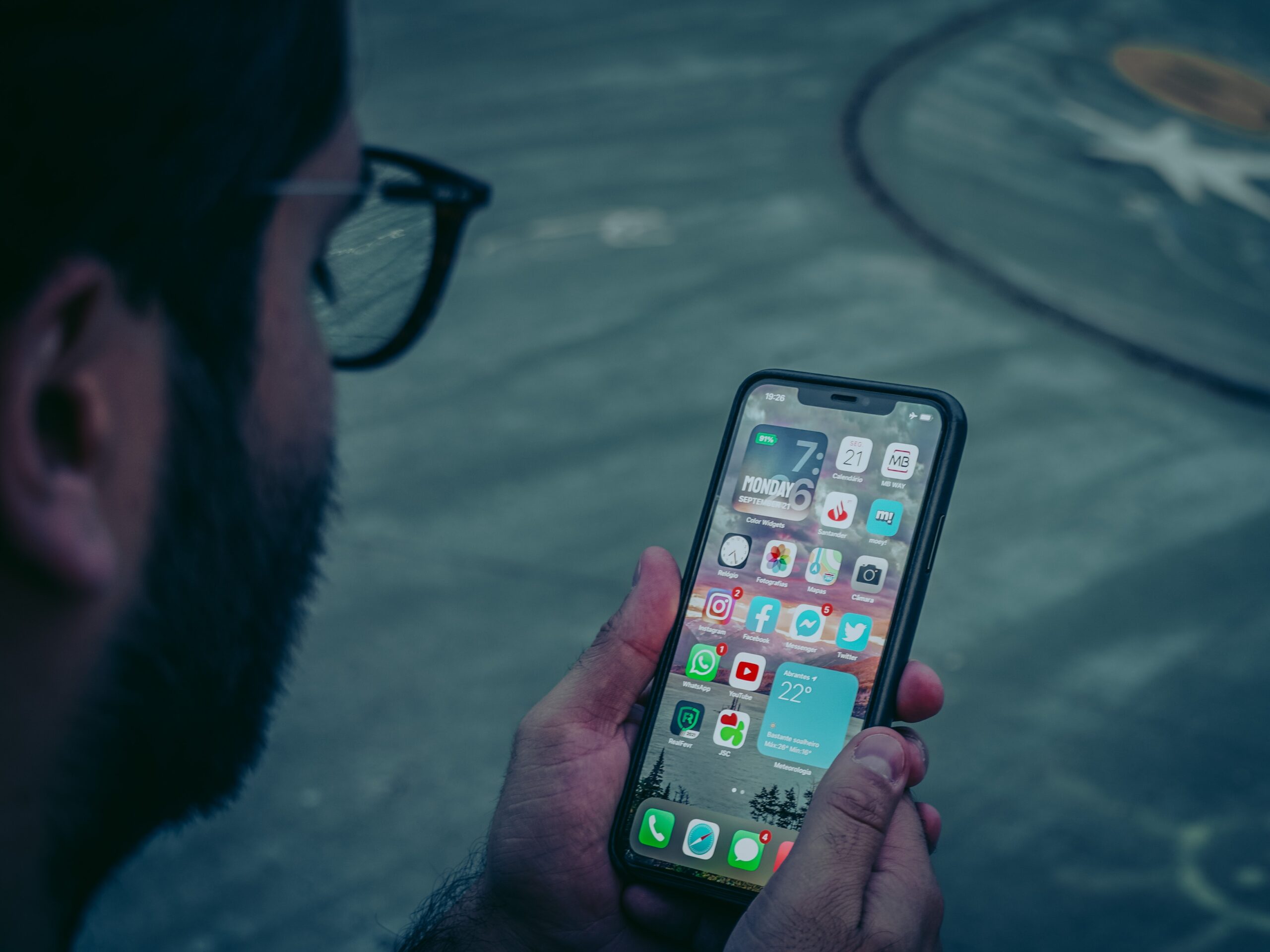
In 1980, when Ronald Reagan took office, the average American only encountered around 500 advertisements or brand impressions per day*. Fast forward to 2025, under Donald Trump’s presidency, and that number has exploded to over 15,000 daily impressions*. This staggering 30-fold increase represents one of the most profound yet underappreciated transformations in American life: the industrialization of human attention.
The Evolution of Commercial Impressions
The data tells a compelling story about how dramatically our attentional landscape has shifted:

- The Analog Era (1980-1988): With limited media channels—three major television networks, local radio stations, and print publications—advertisers could reach most Americans through just a handful of touchpoints. The 500 daily brand impressions had a bounce rate of only 14%, meaning people actually processed and remembered most advertising they encountered.
- The Cable & Early Internet Revolution (1990-2000): Under Bush Sr. and Clinton, cable TV fragmented the media landscape while the internet began its ascent. Daily impressions rose to 5,000 by 2000, with bounce rates climbing to 37% as consumers developed their first significant filtering mechanisms.
- The Digital Acceleration (2000-2010): The Bush Jr. and early Obama years saw digital advertising mature alongside the early social media platforms. Mobile phones became ubiquitous, creating new surfaces for commercial messaging. By 2010, Americans faced 8,000 daily impressions with a 58% bounce rate.
- The Algorithm Era (2010-2020): Social media platforms optimized for engagement while smartphones became primary consumption devices. Streaming services, personalized recommendations, and microtargeting all contributed to a world where commercial messages followed consumers everywhere. Impressions reached 12,000 daily with a 76% bounce rate.
- Today’s Multi-Platform Attention Economy (2025): Under Trump’s returned presidency, we’ve reached an unprecedented 15,000 daily impressions with an 84% bounce rate. TikTok, Instagram, YouTube, streaming services, gaming platforms, smart devices, and augmented reality have all become vehicles for commercial messaging.
The Siege on Our Mental Bandwidth
The implications of this transformation extend far beyond marketing effectiveness. What we’re witnessing is nothing short of an industrial-scale competition for the most precious and limited resource in the digital age: human attention.
The Bounce Rate Crisis
Perhaps most telling is the evolution of the bounce rate—the percentage of impressions that fail to register meaningfully in our consciousness. In 1980, with a 14% bounce rate, most advertising registered. Today’s 84% bounce rate reveals a critical truth: our mental filtering systems have become highly sophisticated defense mechanisms against information overload.
This isn’t just a problem for advertisers. It represents a fundamental shift in how humans process information. We’ve become experts at ignoring, at filtering, at bouncing away content before it can penetrate our awareness. The necessary skill of selective attention has evolved into a reflexive dismissal of most incoming information.
2025: A Typical Day
Tom wakes up and immediately checks her smartphone, scrolling past dozens of sponsored posts and native ads without consciously registering most of them. His smart speaker plays a news podcast interrupted by targeted ads. During his commute, digital billboards change every few seconds, while her navigation app displays location-based promotions. At work, his web browser shows personalized ads on every page, his email contains sponsored content, and social media breaks include hundreds of algorithm-selected advertisements.
That evening, while streaming shows across multiple platforms (each with their own ads), Tom simultaneously browses shopping sites (more ads), checks social media (endless sponsored content), and receives push notifications from apps (additional promotions). His smart TV, gaming console, and household IoT devices all collect data to serve her even more targeted advertising.
Total ad exposure: 15,000, most of which are never consciously registered. When someone mentions a popular advertisement, Tom has to ask, “Which one?” as her attention has become so fragmented and selective that only a tiny fraction of ads break through her perceptual filters.
Living Under Siege: The Personal Cost
The 30-fold increase in commercial impressions has transformed everyday life in ways both obvious and subtle:
- Diminished Deep Focus: The constant interruption economy has made sustained attention increasingly difficult, affecting everything from workplace productivity to personal relationships.
- Decision Fatigue: The overwhelming number of choices and messages contributes to decision fatigue, where mental energy is depleted by the constant need to filter information.
- Anxiety and Overstimulation: Many experience a persistent sense of being overwhelmed, of missing something important amid the noise.
- Attentional Inequity: Those with resources can increasingly buy their way out of the attention economy (premium ad-free services, higher-end devices with fewer interruptions), creating a new form of inequality.
What Cuts Through the Noise: Messaging That penetrates the filter
In the flood of 15,000 daily impressions, messages that connect to our identity, immediate needs, or personal circumstances consistently receive processing priority, and with so many ads competing for our attention, what actually gets noticed?
Here are five types of messages that can break through our mental filters:
Emotional Content
Messages that make us feel something—whether it’s laughter, fear, or inspiration—consistently get noticed. This is why ads today focus more on emotional stories than product features.
Why it works: Emotional content bypasses our conscious filtering because our brains process emotions before rational thought. A touching story about a family moment will register when a list of product features won’t. Organizations that cast themselves as heroes fighting against clear villains (whether competitors, problems, or societal issues) create emotional narratives that instantly cut through the noise. Our brains are hardwired to pay attention to these archetypal storytelling patterns.
Interestingly, research shows that defining a clear villain is even more important than showcasing the hero’s strengths. A 2023 study from Northwestern found that our attention systems are 3x more responsive to negative threats (villains) than positive opportunities (heroes). This explains why successful messaging often focuses less on “how amazing we are” and more on “how terrible this problem is that we’re fighting against.” When Apple positioned itself against conformity in its famous 1984 commercial or when environmental organizations highlight corporate polluters, they’re leveraging this fundamental attention bias toward threats and villains.
Surprising or Unexpected Content
Our brains automatically pay attention to anything that seems different or unexpected. When something breaks the pattern of what we expect to see, we notice it.
Why it works: We’re hardwired to respond to novelty. While we might ignore standard ad formats we’ve seen thousands of times, something unusual temporarily captures our attention.
Personally Relevant Messages
Messages that connect to who we are or what we need right now are much more likely to get through. This explains why personalized advertising has become so common.
Why it works: Research shows including someone’s name in a message increases engagement by 38%. Similarly, ads that address immediate needs (like umbrella ads during rain) can reduce bounce rates by 40%.
Recommendations from People We Trust (Influencers)
We naturally pay more attention to information from friends, family, or trusted sources. This is why influencer marketing and testimonials are so effective.
Why it works: Content shared by people we know has bounce rates about 35% lower than identical content from brands or companies.
Content That Offers Clear Benefits
Our brains prioritize information that promises some kind of reward—whether it’s useful knowledge, entertainment, or social connection.
Why it works: Offering something valuable before asking for anything in return makes us more receptive to messages. Our brains tag these sources as worth paying attention to.
The Responsibility Question
In a world where 84% of ads are ignored, the 16% that do get through have enormous influence. This raises important questions about how these attention-grabbing techniques are used.
The most successful communicators today aren’t necessarily those spending the most money, but those who understand these psychological triggers. This matters not just for advertisers, but for anyone trying to communicate in our information-saturated world.
Conclusion: Reclaiming Our Attention
The 30-fold increase in commercial impressions between 1980’s America and 2025’s America represents one of the most significant yet underappreciated transformations in modern life. Our attention—our very consciousness—has become the primary battlefield of commercial competition.
The rising bounce rate, now at 84%, suggests we’re reaching the limits of what human cognition can process. The next evolution of this struggle won’t be about increasing impressions but about breaking through our sophisticated filtering systems with ever more personalized, emotionally resonant, and precisely targeted messaging.
For individuals, the challenge of the coming decade will be learning to protect and direct our attention intentionally in a world designed to capture and monetize it. For society, the question remains whether we’ll begin to recognize attention as a finite resource worthy of protection or continue to treat it as an infinite commodity to be harvested without limit.
Your attention has never been more valuable—or under more persistent siege.
*Impression = each discrete moment of exposure.






